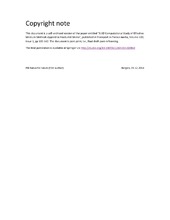A 3D computational study of effective medium methods applied to fractured media
Peer reviewed, Journal article
Accepted version
Permanent lenke
https://hdl.handle.net/1956/9705Utgivelsesdato
2013-10Metadata
Vis full innførselSamlinger
Originalversjon
https://doi.org/10.1007/s11242-013-0208-0Sammendrag
This work evaluates and improves upon existing effective medium methods for permeability upscaling in fractured media. Specifically, we are concerned with the asymmetric self-consistent, symmetric self-consistent, and differential methods. In effective medium theory, inhomogeneity is modeled as ellipsoidal inclusions embedded in the rock matrix. Fractured media correspond to the limiting case of flat ellipsoids, for which we derive a novel set of simplified formulas. The new formulas have improved numerical stability properties, and require a smaller number of input parameters. To assess their accuracy, we compare the analytical permeability predictions with three-dimensional finite-element simulations. We also compare the results with a semi-analytical method based on percolation theory and curve-fitting, which represents an alternative upscaling approach. A large number of cases is considered, with varying fracture aperture, density, matrix/fracture permeability contrast, orientation, shape, and number of fracture sets. The differential method is seen to be the best choice for sealed fractures and thin open fractures. For high-permeable, connected fractures, the semi-analytical method provides the best fit to the numerical data, whereas the differential method breaks down. The two self-consistent methods can be used for both unconnected and connected fractures, although the asymmetric method is somewhat unreliable for sealed fractures. For open fractures, the symmetric method is generally the more accurate for moderate fracture densities, but only the asymmetric method is seen to have correct asymptotic behavior. The asymmetric method is also surprisingly accurate at predicting percolation thresholds.
